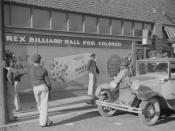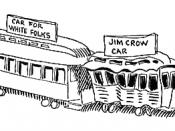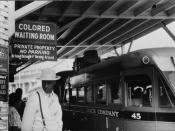Before the Jim Crow laws, African Americans actually enjoyed some of the rights they were given during Reconstruction. This included the 13th, 14th, and 15th Amendments and the Civil Rights Act. However, the rights were dwindled after the Reconstruction ended in 1877; by 1890, whites in both the North and South became less supportive of civil rights. Thus, racial tensions began to grow, and made it even worse when the Supreme Court began to promote racial segregation.
The term Jim Crow is though to have started around 1830 when a white show performer, Thomas "Daddy" Rice, blackened his face with charcoal paste or burnt cork and danced a absurd jig while singing the lyrics to the song, "Jump Jim Crow." Rice created this character after seeing (while traveling in the South) a crippled, elderly black man (or some say a young black boy) dancing and singing a song ending with these chorus words:
"Weel about and turn about and do jis so,
Eb'ry time I weel about I jump Jim Crow."
Jim Crow was not a person, yet affected the lives of millions of people. The Jim Crow era was one of struggle - not only for the victims of violence, discrimination, and poverty, but by those who worked to challenge (or try to demolish) segregation in the South.
Some Jim Crow laws were as follows: All passengers in a station or on a train/bus must have different waiting rooms and bathrooms, as well as different ticket booths. That was in Alabama. Also, the schools for white children and the schools for Negro children had to be conducted separately in Florida. And another one in Alabama, "It shall be unlawful for a Negro and white person to play together or in company with each other at any game of...


